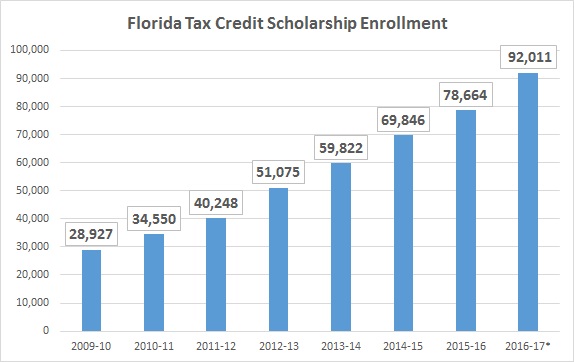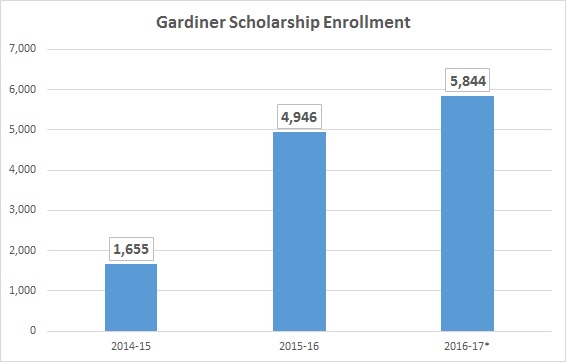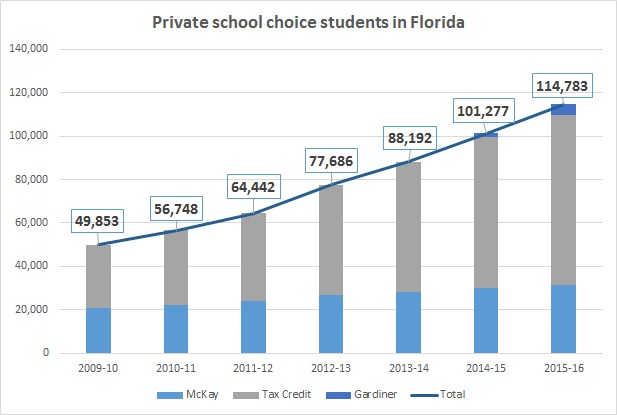
In the new school year, the nation’s largest private school choice program is seeing the largest growth in its 15-year history.
This fall, there are more than 92,000 low-income and working-class children enrolled in private schools with the help of Florida’s tax credit scholarship program. That’s up nearly 17 percent from the end of last school year, when the program served 78,664 students.
Meanwhile, the number of children enrolled through in the Florida’s newest private educational choice program — Gardiner Scholarships for students with special needs — has already increased by more than 900 from the 2015-16 school year. Since applications for that program are still open, it could continue to grow.

Step Up For Students, which publishes this blog and pays my salary, helps administer both the Gardiner and tax credit scholarship programs in Florida. Another nonprofit organization, the AAA Scholarship Foundation, also offers scholarships under both programs, but has not yet released its enrollment numbers for the 2016-17 school year. Last year, it provided 451 tax credit scholarships and 256 Gardiner scholarships.
Meanwhile, the McKay scholarship program, which provides vouchers to students with special needs, served more than 30,000 students last year. Numbers for the current year are not yet available, but if recent trends hold, it’s likely the total number of children participating in Florida’s three K-12 private school choice programs will climb north of 125,000.

The tax credit scholarship program has traditionally been open to students who qualify for federal lunch programs, which means new students had to come from families with incomes below 185 percent of the federal poverty level. A law signed by Gov. Rick Scott in 2014 made partial scholarships available to families with incomes up to 260 percent of the poverty level, or roughly $63,000 per year for a family of four. As of Wednesday, 1,896 students, or approximately 2 percent of those who received tax credit scholarships from Step Up so far this year, fall into this new category.
The average household income of participating families remains close to $24,000 per year, and 55 percent of scholarship recipients live in single-parent households.
Annual evaluations of the program have consistently found scholarship students are more disadvantaged than their public-school peers, both academically and economically. This year, roughly 39 percent of scholarship students are Hispanic, while 30 percent are black and 26 percent are white.
Step Up’s numbers show the scholarship program grew unevenly across the state. The growth rate in Pinellas County, a school district of more than 100,000 students that was recently the subject of a Pulitzer Prize-winning expose, largely tracked the statewide average. In Osceola County, a rapidly growing Central Florida district that’s seeing an influx of new arrivals from Puerto Rico, the program grew by more than 19 percent. Among large-to-midsize districts, Polk County stood out, growing by nearly 33 percent.
In some districts, including the affluent Jacksonville suburb of Clay County, scholarship participation grew much more slowly than the state average, and in some rural areas, like Franklin County, home of the state’s top-performing rural charter school, it actually declined. A full county-by-county breakdown, current as of Thursday, is available here.
In a statement, Step Up For Students President Doug Tuthill underscored the significance of the statewide numbers.
“Florida is a national leader in expanding educational opportunity, and the latest numbers again show that parents appreciate the power to access additional options that can best serve their children,” he said. “We are proud to be part of this growing, bipartisan movement to strengthen public education.”
Correction: An earlier version of this post included county-by-county enrollment totals that were tabulated incorrectly. This post has been updated to reflect the accurate numbers, which do not affect the statewide trends. We regret the mistake.


